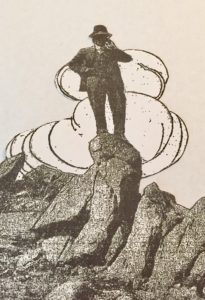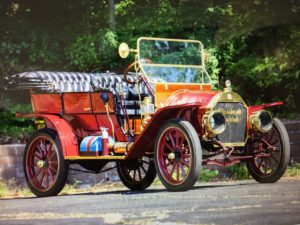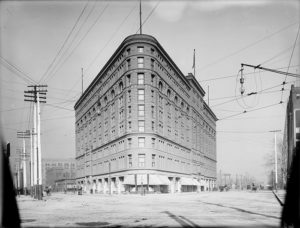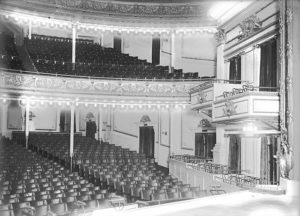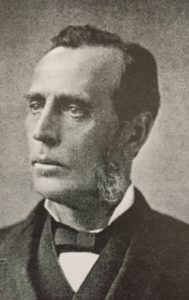Story
Auto Record-Setter and Murderer’s Friend: Frank P. Loveland
The first automobile appeared in Louisville, Colorado in 1904. The year the first Denver resident bought a car is not known. But, the first trip by automobile from Morrison to the top of Mount Falcon, an elevation change of over 2,000 feet, took place in 1910.
The man who at age twenty-four accomplished this feat was Francis Percy “Frank” Loveland. He was a member of the social elite and of a prominent Colorado pioneer family (hint: Loveland Pass). Born in Denver on June 11, 1885, Frank attended East High School which was on Stout Street between 19th and 20th at the time. His parents sent him to Yale University, where he graduated in 1908.
The first automobile up Mount Falcon
Frank owned a very expensive, luxurious seven-passenger Stoddard-Dayton car. In June 1910 he drove his touring car with two passengers from Morrison to the summit (elevation 7,851 feet) of Mount Falcon, an ascent which had never been made by an auto. Bets were made that Frank wouldn’t reach the top, but he did in twenty minutes. An hour earlier, he had set a record time of twenty-nine minutes for the drive from the Capitol Building to Morrison.
The road up Mount Falcon that Loveland drove on had been used by carriages to go to the home of John Brisben Walker, who owned all the land of Mount Falcon as well as what is now Red Rocks Park. The upper part of the road today is the popular Castle hiking trail with eastern trailhead at 3258 Vine Street in Morrison. The hiking trail leads to the stone ruins of Walker’s home, which was built in 1909 but burned down in 1918.
J. B. Walker, a car enthusiast like Loveland and a car factory owner, had attempted to climb Pikes Peak in an auto in September 1900 long before Spencer Penrose improved the rutted wagon trail into a roadway. In the car with Walker for the Pikes Peak attempt (which failed) was Walker’s son, J. B. Walker, Jr., who was also one of the passengers in Loveland’s car when Loveland motored up Mount Falcon.
President William Howard Taft was expected to visit Denver in the fall of 1911. Walker, Sr. had broken ground for a house on Mount Falcon that he hoped would be the summer residence of presidents. Walker proposed to the visit’s planning committee that the president’s schedule include a trip up Mount Falcon. Walker also suggested that since Frank Loveland had made the trip in twenty minutes he should be the one to drive Taft up. Taft did come to Denver, staying at the Brown Palace Hotel on October 3, 1911, but it is not known if Frank drove him up Mount Falcon. Due to lack of funds, the proposed Summer White House never proceeded beyond the 1911 cornerstone and partial foundation, which is still visible today.
Loveland had an automobile as early as 1906, since he drove some Princeton boys down to Colorado Springs and the Broadmoor in his car in early September of that year, before university classes started. The month before his record-setting runs, a Denver Post columnist inferred that Frank loved his car so much that he never walked anywhere. She said, “Maybe you have seen Frank Loveland walking, but nobody else ever did. Once someone saw him walk a few feet from his car into the theatre.”
Friend of a man convicted of murder
“Frank Loveland” (referring to Francis P. Loveland) appears on nine different pages of the 2003 nonfiction book, Murder at the Brown Palace: A True Story of Seduction and Betrayal. The book tells the story of Frank Henwood, 35, who on Wednesday, May 24, 1911 shot and killed Tony von Phul and bystander George Copeland in the Marble Bar at the Brown Palace Hotel in Denver. The Brown Palace had attracted high society since it opened its doors in 1892, nineteen years earlier.
Note: As of 2017, the Brown Palace is still a luxury hotel and is celebrating its 125th anniversary with special events to mark the occasion. One event is the introduction of a 125th anniversary single malt whiskey made with the Brown Palace’s artesian water.
Both Henwood and von Phul were enamored with Isabel Springer, 31, but her husband, John W. Springer, was clueless about their affections. The jealous Henwood did not stand trial for the death of von Phul, because authorities feared that Henwood would claim self-defense. Instead, he was tried for the murder of the bystander and was convicted.
Frank Loveland (25 at the time) was Henwood’s best friend, and they were partners in a gas company. Henwood had just come to Denver in 1910, and Loveland introduced Henwood to other young society members. The frequent mention of Loveland in the book was due to Loveland giving interviews to the press and making visits to Henwood in jail.
Loveland was also a friend of Mr. and Mrs. Springer. In fact, together on Sunday, May 21, Loveland, Henwood, and the Springers attended the opening night of Ziegfeld’s Follies of 1910 at the Broadway Theater. The night before the murder, they went together to the vaudeville show at the Orpheum Theater. John Springer’s ranch home south of Denver is now known as Highlands Ranch Mansion and has been greatly enlarged. Ironically, after Henwood’s sentencing hearing, Loveland’s phone call to Henwood to find out the result was from the Springer ranch.
Although Murder at the Brown Palace extensively mentions Frank Loveland, the book gives no other background information about him. His automobile exploits are not revealed, nor is his being from an important family in Colorado’s history mentioned.
Eminent and wealthy ancestors
Frank P. Loveland’s grandfather, William Austin Hamilton Loveland (1826-1894), was a remarkable Colorado pioneer. In 1859 he came with an ox train of merchandise to Colorado in order to open a general store (which still stands) in what would become Golden. W. A. H. Loveland was a stage-line owner, railroad builder, Rocky Mountain News owner, philanthropist, trustee of the Colorado School of Mines, mayor of Golden, and candidate (unsuccessful) for Governor. He was also one of the founders of the cities of Golden and Lakewood. Loveland Pass and the city of Loveland are named after W. A. H. Loveland.
Frank P. Loveland’s father, Francis William Loveland (1857-1921), was a prominent entrepreneur and University of Denver law school graduate who managed a diverse array of businesses including railroads, a newspaper, coal mines, ranches, and irrigation ditches. Francis W. was involved in the operation of many of the businesses owned by his father, but was important in his own right. He was also a Colorado pioneer, coming to Colorado when he was a toddler. Francis W. was sometimes called “Frank” just like his son.
High society and US Army
Frank P. Loveland served in the US Army in World War I from August 5, 1917 until early 1919. Judging by newspaper accounts of society functions, in the years between his Yale graduation and entrance into the Army, Frank attended a constant stream of theater performances, luncheons, country club parties, balls, and dinner parties. During this time, including the time of the auto races and murders, he lived in his parents’ mansion at 850 Logan Street—one of three mansions torn down to build the present-day 888 Logan Street highrise. The mansion was approximately 5,000 square feet and two and one-half stories high (i.e., three stories where the third story had sloping walls and dormers).
During World War I, Frank was a first lieutenant with the 115th Trench Mortar Battery. After being discharged from the Army, Frank lived in or near Berthoud. The Yale 1920 Alumni Directory shows his address as “Box 206, Berthoud, Colorado” and shows his college major as “Agr.” which must be an abbreviation for “agriculture.” It is likely that Frank was managing the ranch his father owned near Berthoud, which would have been a far cry from the society life he led in Denver.
Judith Stalnaker, PhD is a retired Civil Engineering professor who is interested in Denver and Colorado History. She is the author of the 2015 five-part History Colorado blog series entitled 888 Logan Street: Home to the Prominent.
References:
Allard, Leola, “Auto Walk the Worst Ever,” Denver Post, May 26, 1910, p. 9.
“Class of 1908,” Alumni Directory, Yale University, 1920, p. 132.
Conarroe, Carolyn, The Louisville Story, Johnson Publishing Co., Boulder CO, 1978, p. 53 (first auto).
“F.W. Loveland, Pioneer, Will Be Buried Tomorrow,” Rocky Mountain News, March 20, 1921, p. 5, sec. 1 (obituary).
“John Brisben Walker Tries to Ascend Pike’s Peak in an Automobile,” Chicago Tribune, September 24, 1900, p. 8.
“Kind Messages Pour in on the Prisoner,” Denver Post, July 28, 1911, p. 4 (phone call from Springer ranch).
Kreck, Dick, Murder at the Brown Palace: A True Story of Seduction and Betrayal, Fulcrum Publishing, Golden CO, 2003, pp. 20, 24, 48, 50, 92, 100, 114, 139, 140.
“Loveland Climbs Mt. Falcon in an Auto in Twenty Minutes,” Denver Post, June 6, 1910, p. 5.
“Loveland Makes Great Run to Morrison,” Denver Post, June 5, 1910, p. 27.
Rocky Mountain News, September 2, 1906, p. 26 (auto trip to Colorado Springs).
Smiley, Jerome C., History of Denver: With Outlines of the Earlier History of the Rocky Mountain Country, Denver Times-Sun Publishing Company, Denver, 1901, various pages between 284 and 666 (W.A.H. Loveland bio).
“Taft Will Name Dates for Denver Land Convention,” Denver Post, August 29, 1911, p. 5.

